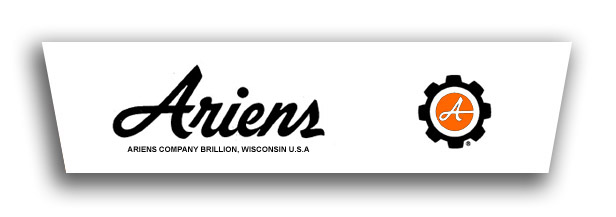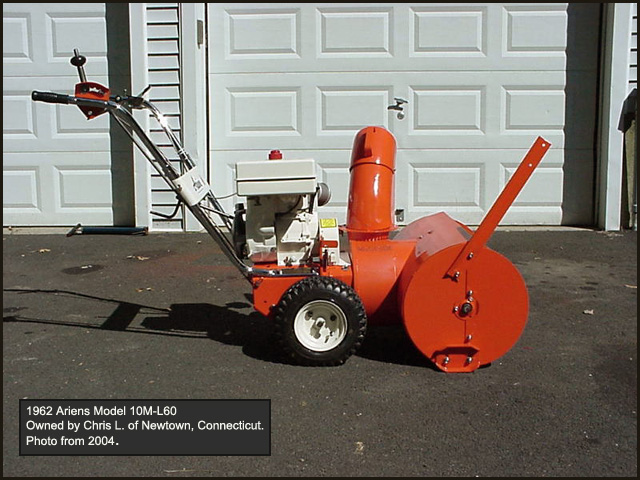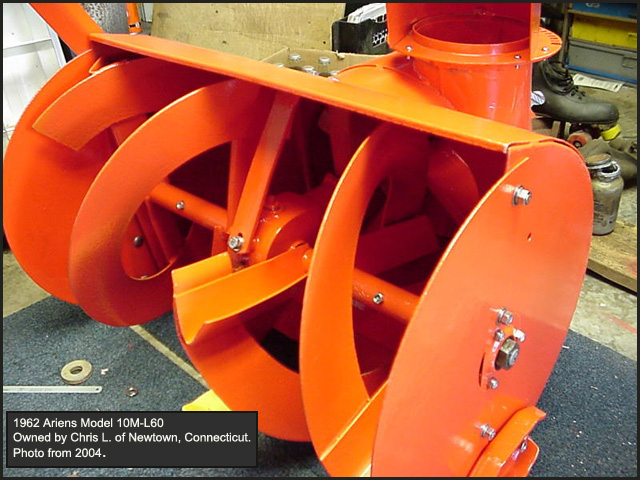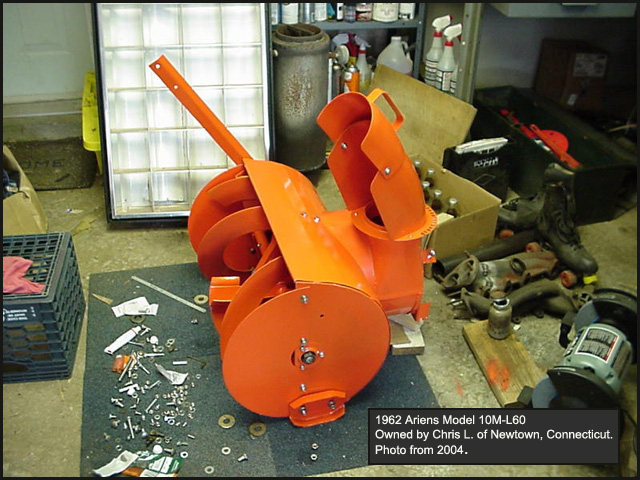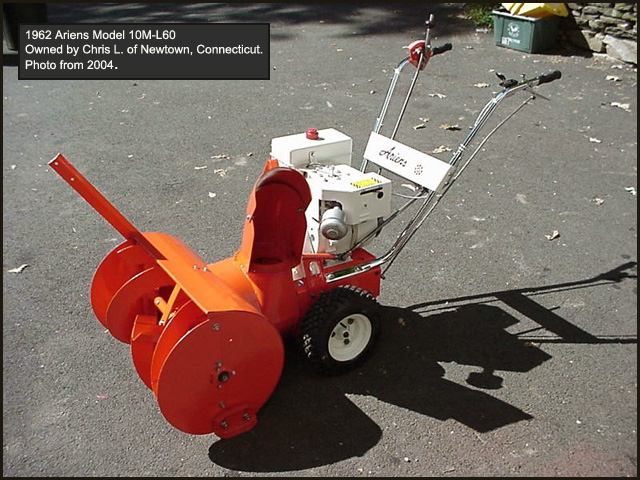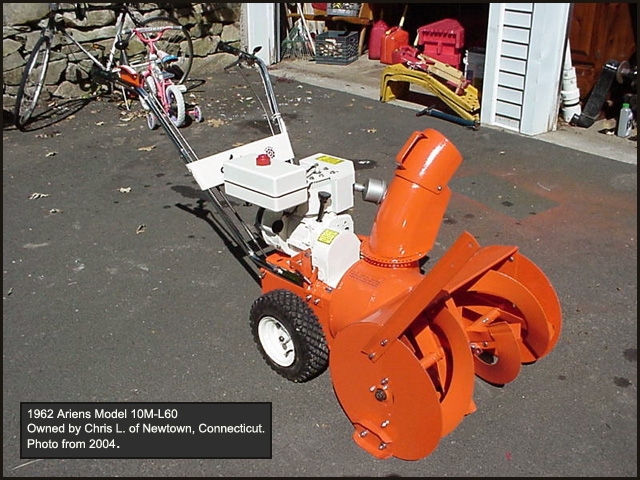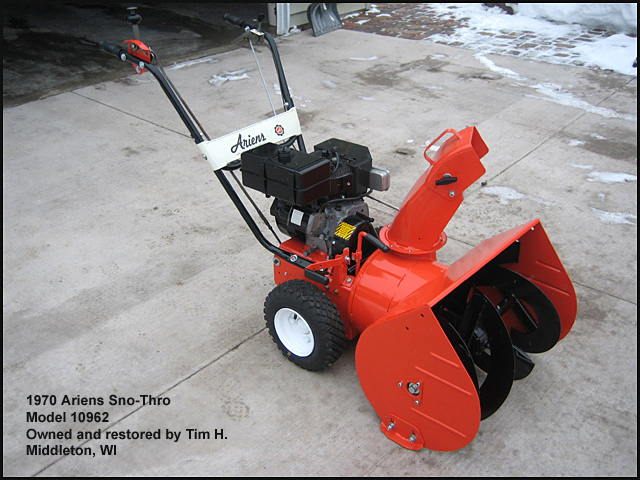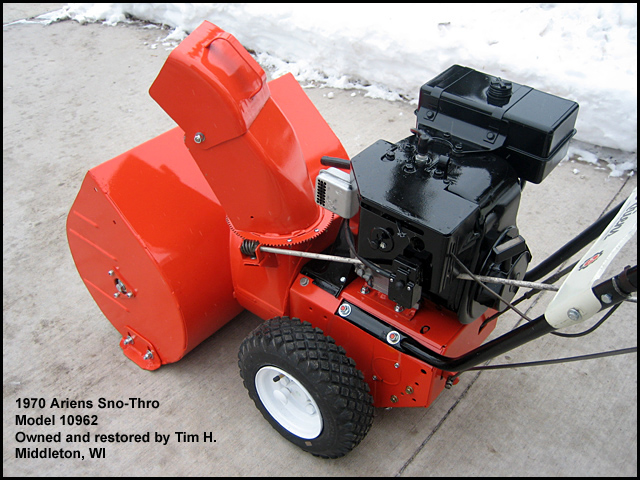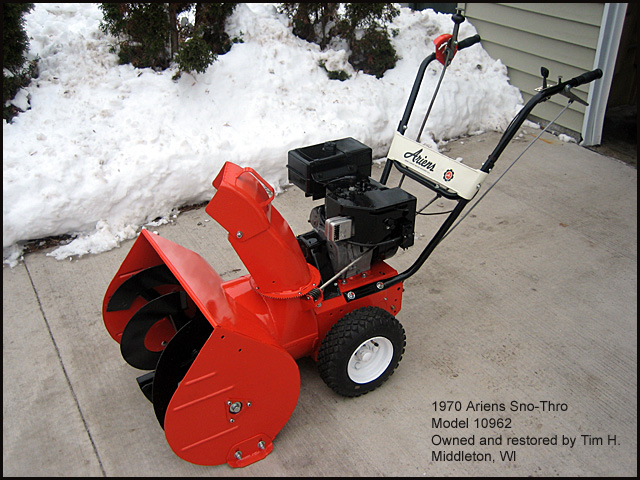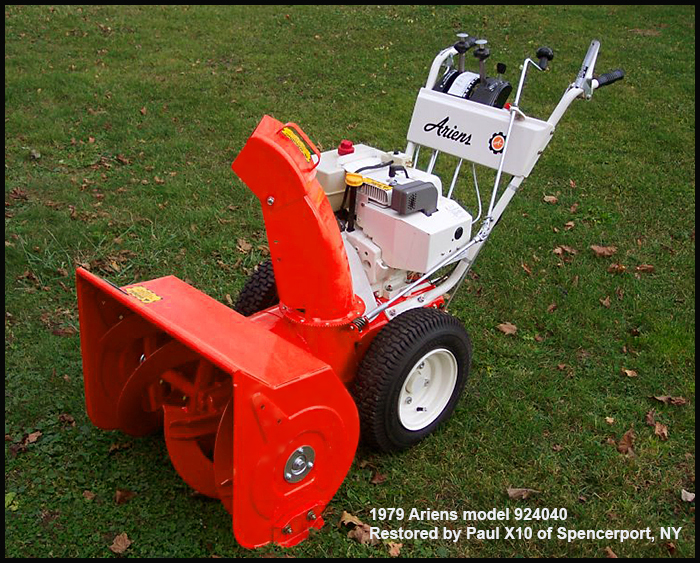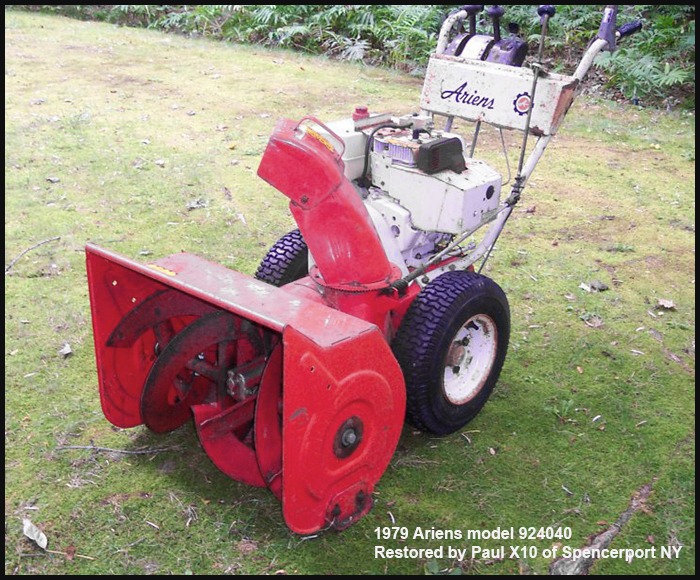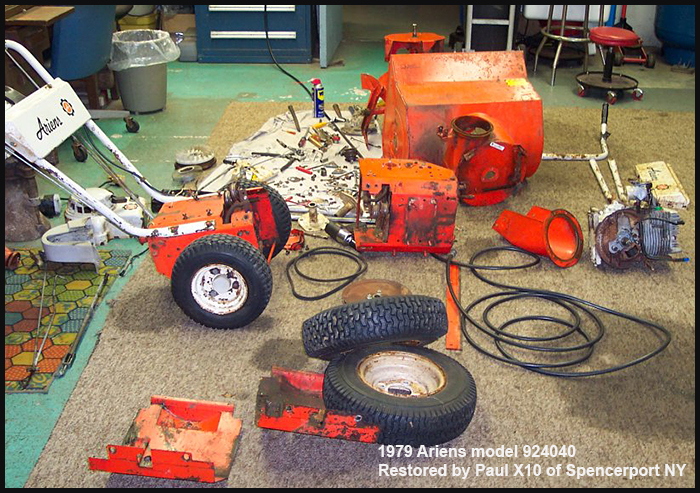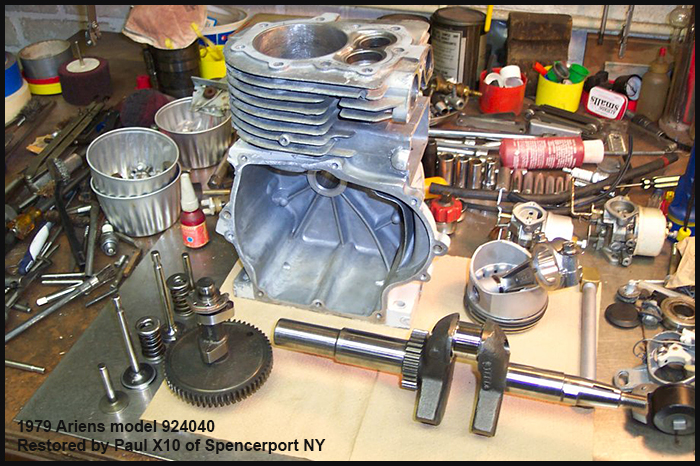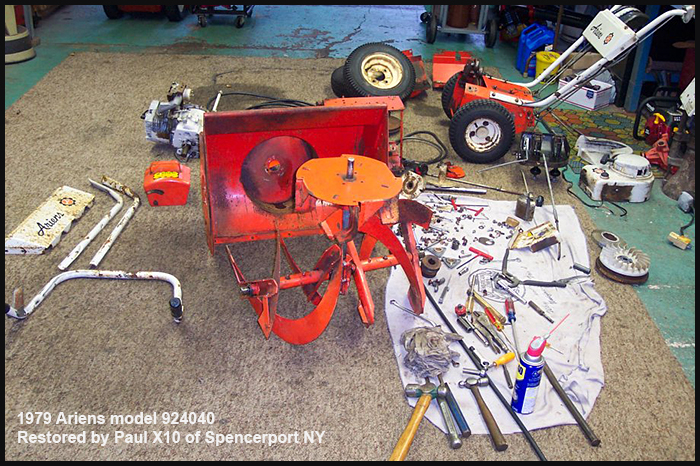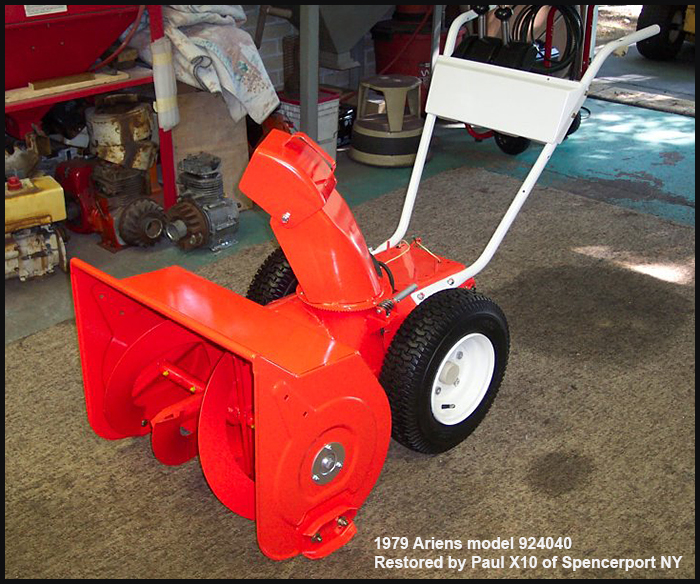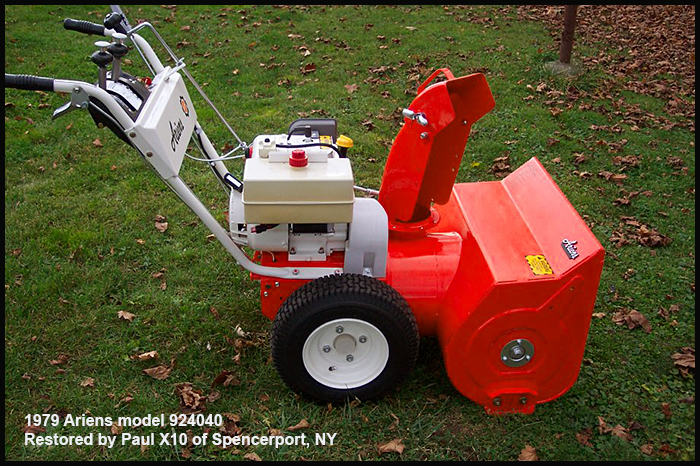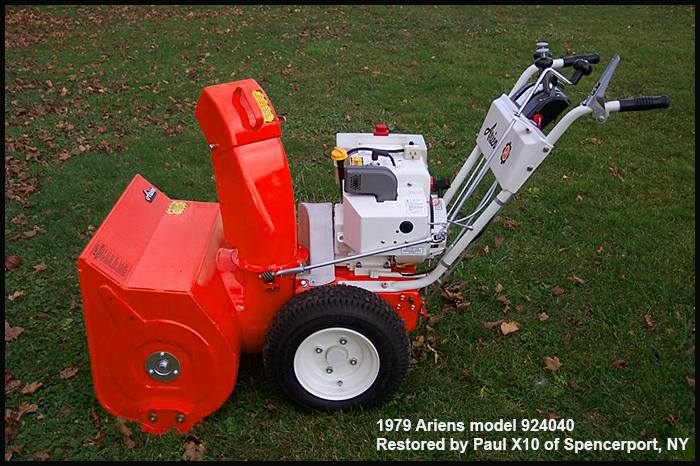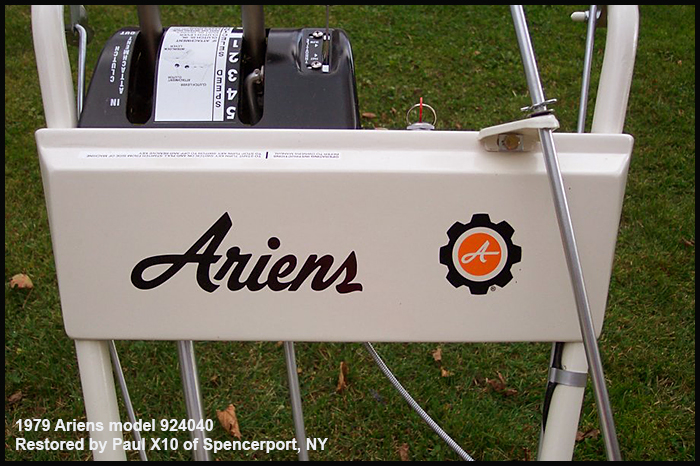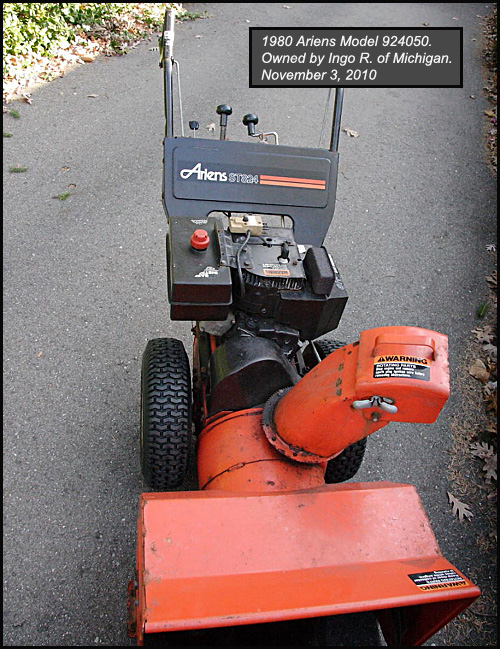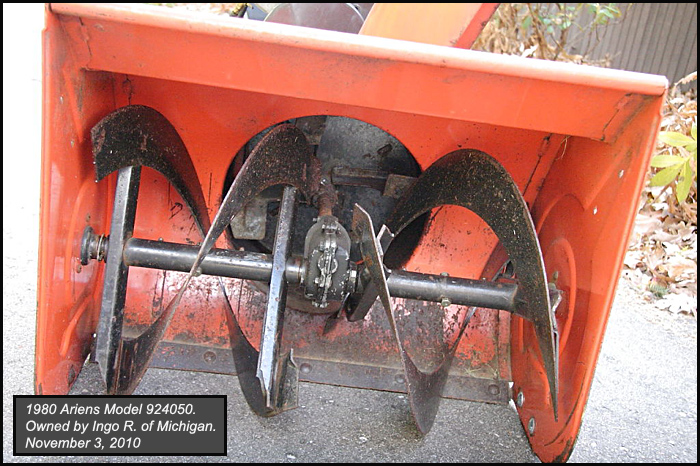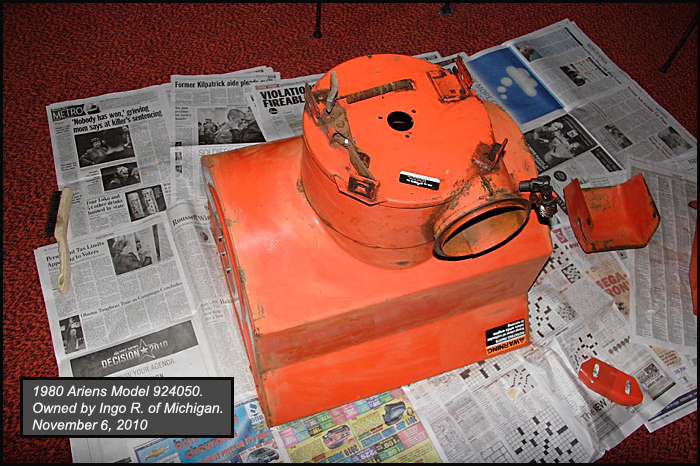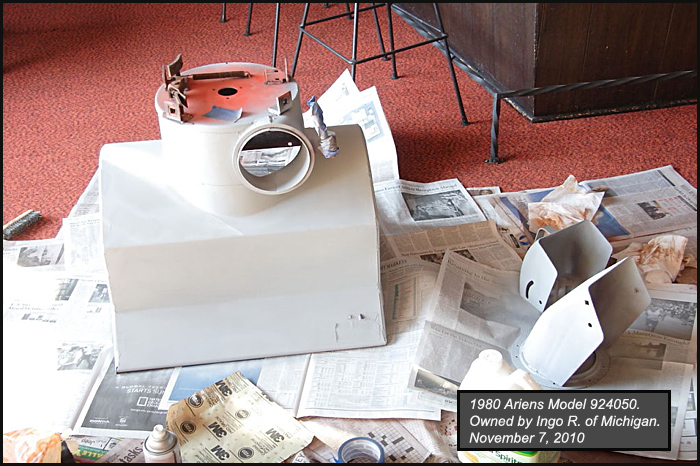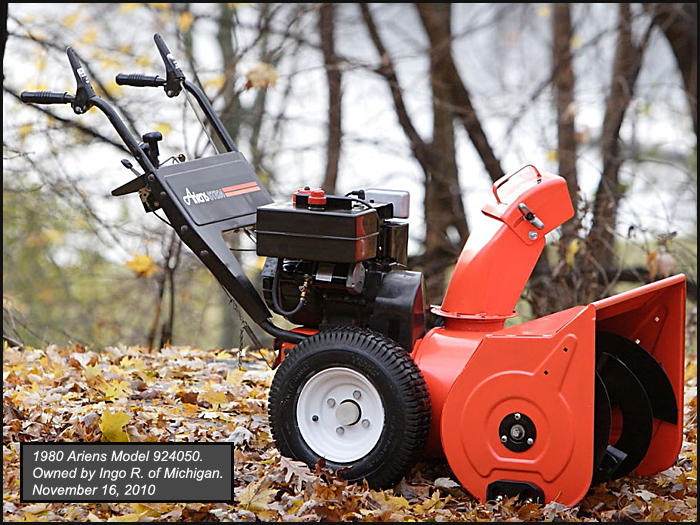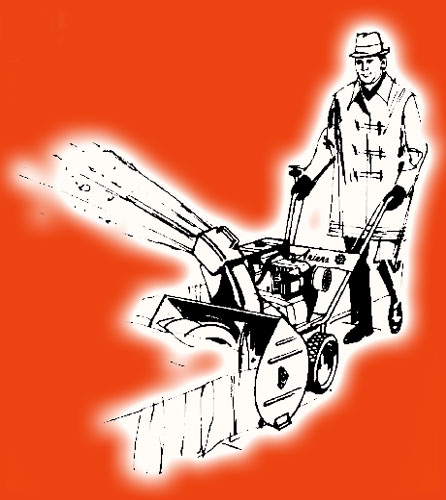1969
Ariens model 10962
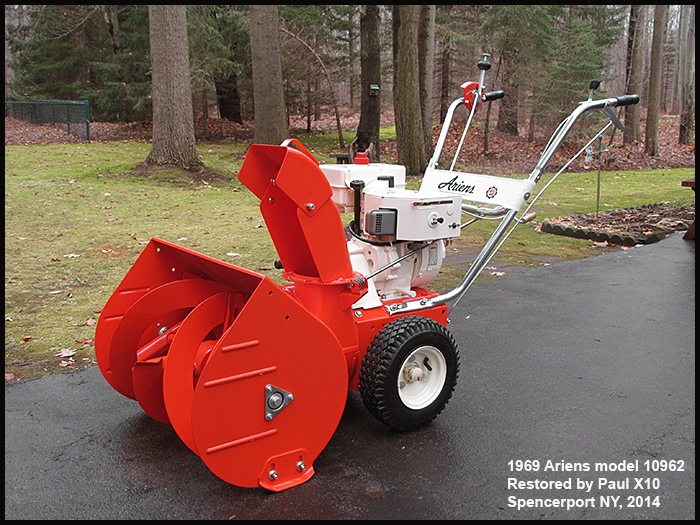
This is
a 1969 Ariens 10,000 series,
model 10962, 7hp, 24" bucket. This
machine was restored by Paul X10 of
Spencerport NY. Paul has done classic
car restorations! He has all
the equipment and skill to do
excellent work on snowblowers! which
is a
new hobby he got into a few years
ago..Paul restored this machine for
his friend's father in 2014. Here is
Paul to tell us the story of this
machine:
1969
Ariens
7/24
Model #10962; Serial #011668
I
started
on this machine for my good friend
Eric's father, Tom, who
needed a second machine to have at his
lake house. He already has a
2012 Ariens Premium with heated hand
grips at his home. He just needed
something to have on hand for when they
have to get in there to work
on, and check on the place over
the winter season.
Well,
Tom
has
an Ariens background, as he started
working at
a hardware store called
Country Gentlemen when he was 12,
back in the mid 1960s, and they
sold and serviced new Ariens
Snow Blowers. He worked on setting up
brand new Ariens
Snow Blowers, and eventually
learning how, and doing the service
work on them for many years; a true,
hardcore, devoted Ariens owner
with many wonderful stories to
tell! So, for me to 'fix-up' an old
Ariens for a man with those
'credentials', pretty much put me in a
perspective and need to do this one a
bit extra special.
I
asked
Eric if he'd want a newer model, or 'old
school', and he didn't
hesitate with saying 'dad would
definitely want old school'. Since
I had quite a few to choose from, I
pointed out an old, rusty 1969 7/24
with a great engine, and he
said.....okay, that will do the job. I
told
him I'll go through it and change the
oil, belt and rebuild the carb,
and anything else it needs to be
reliable.
I
tried
to do only what I said I'd do, but me
being me, and the new owner
having such a 'history' with Ariens
machines, I had to try and
make it look a little better....it was
just so rusty. I had been
working at it a little at a time, and it
was basically apart, and
being November, the weather here in
upstate NY was wet and chilly. Then
the weather report said we'd be in the
upper 60�s and
sunny for a few days, and that made
my decision to just go for
it, because if I'm going to paint
everything, I really need to do
it outside due to the mess the
Rust-Oleum overspray makes, as it's very
slow drying, and sticks to everything.
Having
done
the
restoration on a 1979 8/24 for my
brother over the
summer, I had a system down pretty good,
and knew how to expedite
things a bit better, as a 'weather
window' isn't going to last. I
finished dismantling everything, and got
busy sandblasting, power
sanding, wire wheeling, and cleaning. I
just wanted to get all the
paint work done, so the parts could be
drying for a few days while I
worked on the engine and other
components.
There's
a
couple
items I had to swap out from other year
machines due to
condition and better function. The auger
assembly is from a late serial
number 1974, as that is when Ariens
redesigned the discharge
impeller/fan to the 'less is more' blade
design. These have a scoop at
the 4 ends only, instead of the full
sized 'V' scoops used from the
beginning in 1960. I wanted that for the
efficiency/improvement, as
those evacuate the snow better and throw
it farther, as this
machine's purpose was to be used.
I
also
used a set of decent chrome handlebars
from a 1971
model, which are different because
they did away with the clutch
handle lock button around then. I
thought about drilling it, but the
original process was a punched hole, and
the depressed area from the
punch process was actually needed
for the button to work correctly.
I
added
the extended dipstick as they are simply
so much easier to use,
and 'inspire' checking the oil! The red
plastic gas cap is a
replacement snowblower item, as it's
designed to keep snow/water/ice
from plugging the vent hole. The
original is painted metal with a
crossed cover welded on over the vent
hole to prevent ice from plugging
it. I found out just how important the
cover is, as the cross fell off
my father's old machine, and as I was
using it, ice formed on the hole,
and it vapor locked and died!
One
item
nobody
will notice is, I used the worm gear for
the discharge
chute rotation from the late 1974
model, because Ariens changed it
from a 4 tooth to a 6 tooth design,
which rotates the chute
further with less revolutions of the
crank handle.....small thing, but
there is a difference in how much faster
it is!
Note:
I
wrote
about restoration techniques and
materials I used for the 1979
Ariens 8/24 in another article in this
section, so refer to that for
more about what I used and how I did
certain things.
The
'off-white'
on
this machine was done using Krylon Gloss
Ivory (#51504)
over a red oxide primer. With it not
being an 'engine enamel', some
discoloring occurred around the muffler
area, but it's well hidden by
the carb heater box. After painting the
whole engine, I thought about
the gas tank, and any spills will likely
affect the paint. One thing
I've learned is to 'heat cure' paint,
and it's durability and
resistance to chemicals improves
dramatically. Knowing that gas tank
was absolutely gas free, I spent some
time heating it up with a heat
gun a half dozen times to the point it
felt hot; my estimate around
200�. I did find out it worked, as gas
was spilled on it, and
didn't affect the paint.
The
toughest
aspect
to deal with of this era machine
are the handlebar
panels with the Ariens embossed
logo. Finding a nice one isn't
easy, if not impossible, as they are
thin aluminum, and are usually
bent, cracked, faded and corroded.
Restoring one really isn't an option
with the raised decaled embossing and
thin material. They are a
discontinued item, but Ariens has a
'replacement', and they're
about $100. They are not like the
original, as it's a panel they used
on a rototiller, and they 'fit', but are
made and look totally
different. The one on this '69 is
the best I could find, and with
a little straightening, epoxying two
small cracks, and a touch-up of
the off white along the top and bottom
edges, it was 'just
presentable'. The old part number is
002033000, and is superseded with
Ariens #50203400, which is an
Ariens rototiller part.
My
father
bought
a new 10M6 Ariens on January 24,
1966, for $259.95,
(and went back 3 days latter for a set
of tire chains for
$8.50), just a couple weeks before
the 'famous blizzard' hit the
Northeast; I was 10 years old. That
machine was used every year, a
lot, until
2013 when it was time to retire it
even though it still ran with
its original engine, never rebuilt.
One
thing
my
father did the first year was to remove
the panel from the
handlebars, as it 'got in his way trying
to pull start the engine'. It
ended up in his tool room at the
old farm house, only for me to
rediscover it in 2012, in excellent
condition. It was
different, as the '65/'66 model
year had the mounting holes
(slots) only a quarter of the way
down from the top edge, with
later versions having the holes on
center. Also, it was an almond
color, and the paint was very nice. I
matched the color to Rust-Oleum
Almond (#7770), and this panel is
now on a partially restored
1971 7/32, now in the possession of
Scot. I looked up the part number,
and Ariens Parts Radar shows the same
number as the later panels that I
mentioned in the previous paragraph,
which means this earlier design is
not available, either. That's one
rare panel on Scot's Ariens!
The
other
'tough
aspect' of this era are the chromed
handlebars. The decent
ones I used were cleaned up to look as
good as I could get them, but
they're far from perfect. I
talked to my Ariens dealer if
they're
still available, and they are, but the
right hand lower now
only comes painted black. They're
quite expensive,
too. Re-chroming is also very
costly, and having a set that's not
rusty & pitted to start with is
important, as the work to get the
tubes smooth and pit-free is an extra
plating cost. Some machines
from the late '60s came with the almond
or off-white painted bars that
I've found are on machines that
came without the factory
differential option. Having decent used
painted bars make it a bit
easier to do a repaint, as the chromed
bars would have to be sent to a
plating shop to have the old chrome
removed if you wanted to just paint
them.
I
wish
I had taken more pictures of it 'in
progress', but didn't know it
was going to end up getting so much
attention. With all I did,
documenting this would have resulted in
having almost 100
pictures. The engine was in very good
condition, but I did dismantle it
for the basic rebuild and cleaning,
lapped the valves, new gaskets,
rings, connecting rod, and such, because
I had them on hand already. It
got a new belt, bushings, bearings and
rubber drive wheel, so this is
as close to 'new' as I could get it.
There's
a
few
decals I saved by masking them off
during sandblasting or
sanding. The best part was putting the
big Ariens SNO-THRO decal on the
corner of the bucket over that new
paint!
I
do
feel calling this Ariens 'restored'
is fine, but the real
meaning of that word is "to return
something to it's original
state". In my decades of classic
car work, I've done
restorations in preparation for
judged events. It's very
hard and tedious work, and
expensive. I basically had more
fun on the ones that didn't have to be
'factory correct', as it's a bit
more relaxed, and creative. There's a
word that I use, and it's not in
the dictionary, but I wish it was, as
it's used by some to help
categorize something that's done to
bring a car back close to it's
original condition, but with a few
creative touches, and the word is
'restified'. It means "to return
something close to its original state".
Delivery
day
was
fun, as they didn't know I went this
far. I had it in my
shop covered up with old blankets
in a lineup with 5 other old
Ariens machines, just to be able to say
'which one do you want'. Eric
was suspicious, as he's known me for
years with all the classic and
muscle car work I've done (including his
own big block Chevelle
SS), so when I took the cover
off, Tom saw it, and he said 'I
think I want that one',
and was thrilled. Many discussions,
stories and 'silly name calling' erupted
from that point, as this
machine had been on the Snow Blower
Forum and our Ariens Dealer's home
page for almost 4 weeks at this point,
and I could finally tell them!
It got put to use two days
later with our first real snow
storm, and it did what an Ariens
does....and did it very well!
I
wanted
to say here, that a good part of my
inspiration in doing these,
and taking this on as a hobby, is
knowing there's others out there
that do appreciate these older Ariens
(and other machines), and thanks
to this web site and the Snow Blower
Forum, this 'hobby' will likely
continue to grow, and many more of
these great machines of
yesteryear will be saved,
preserved, used and appreciated.
Long
Live
Ariens!
Thanks
Scot!
Paul
X10

November 2014
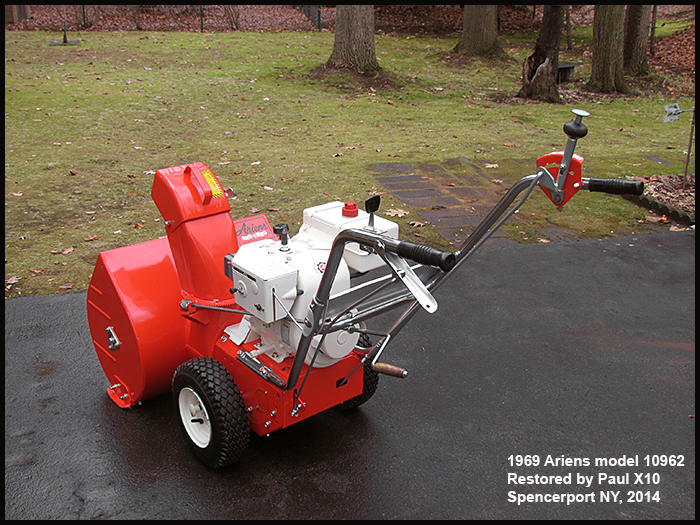
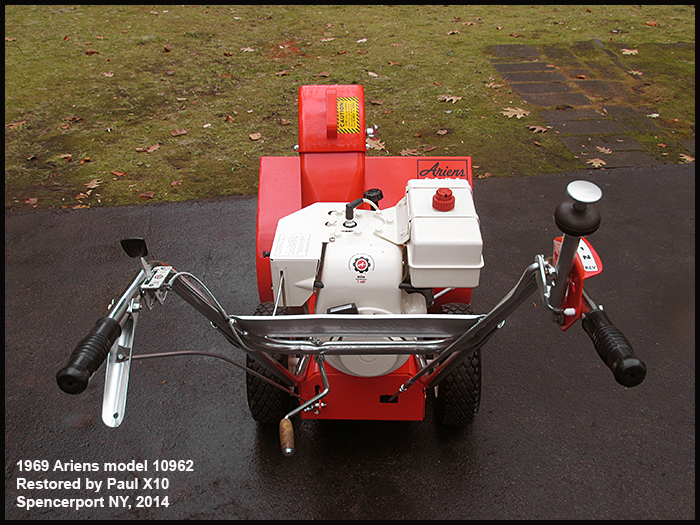
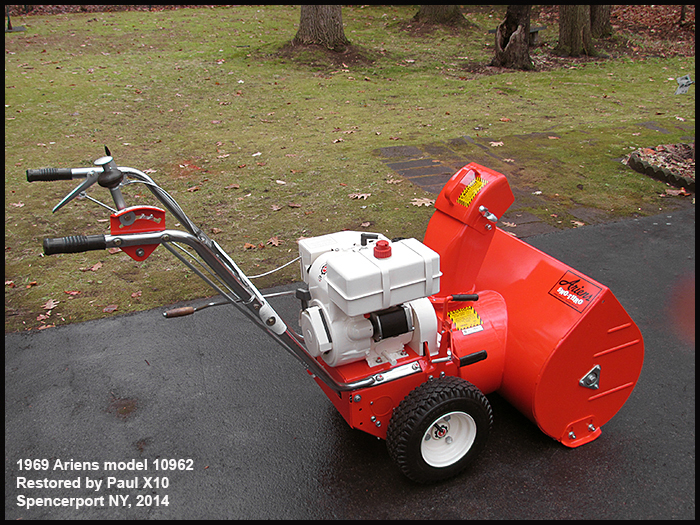

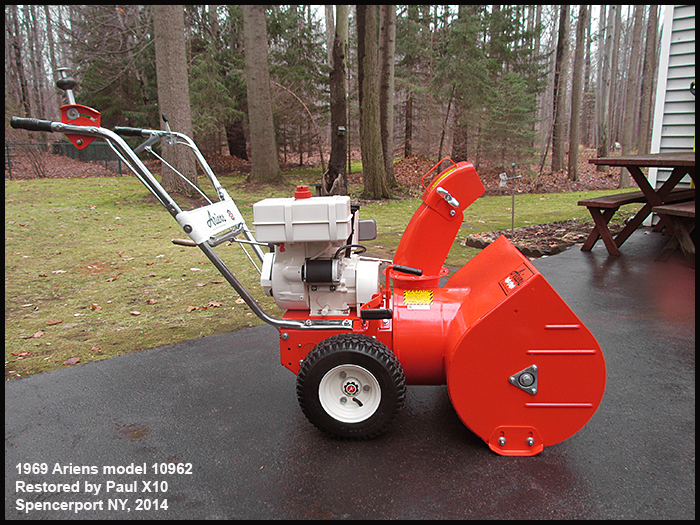



Beautiful
job, thanks Paul!
|
